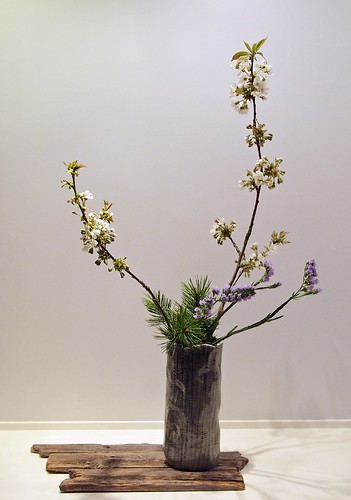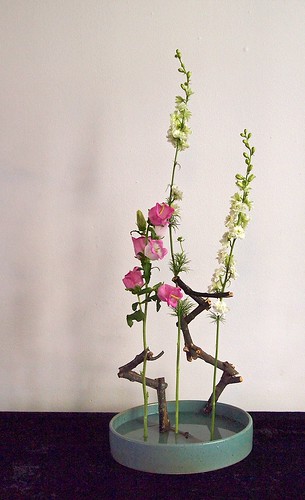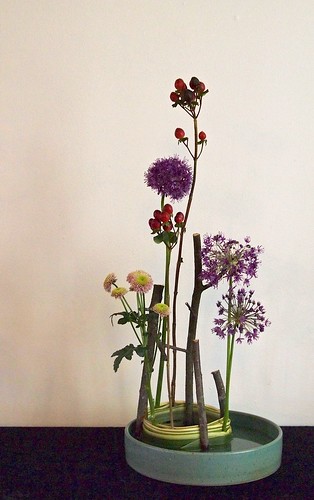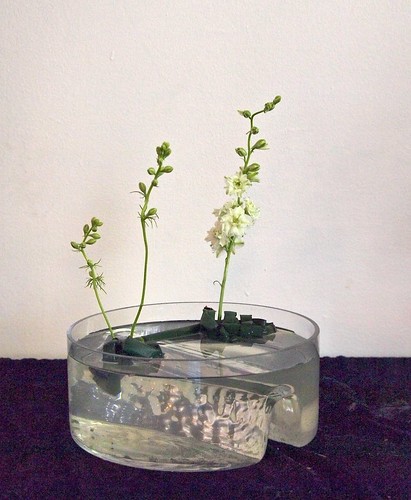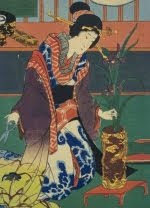Freestyle with vegetables.
Rhubarb, dudhi gourd, turnip, potatoes.
Rhubarb, dudhi gourd, turnip, potatoes.
Freestyle arrangements with fruit and vegetables is a popular style of Sogetsu ikebana. The idea is to make use of the shape, colour and texture of the fruit, when composing a modern, sculptural arrangement. It can be an arrangement with fruits only, or a combination of fruits, leaves and flowers.
This freestyle arrangement is a further development of the more traditional morimono style, which in the Sogetsu school is a basic style arrangement on a tray, with fruits or vegetables, roots and flowers, representing the shin, soe and hikae elements.
While fruit offerings have a long history, both in traditional Japanese culture and in Buddhism, the first morimono style ikebana appeared in the mid 18th century, as part of the litterati or bunjin movement. Japanese literati style was inspired by the Chinese, but since Japan was cut of from the outside world in this time, the influences were sparse and the Japanese bunjin came to develop a style of their own.
The bunjin movement was a revolt against orthodoxy, with its increasing focus on techniques and details. Idealizing the sensibilities of Chinese scholars and painters, the intellectuals preferred a more informal, personal expression. The intellectual, or literati, should ideally be a master of all the core traditional arts - painting, calligraphy, and poetry. Mastering flower arrangement was also in their portfolio. Seeing themselves as renewers of Japanese culture, they developed a category of new freestyle arrangements that are known as bunjin-ike or bujinbana.
Being an informal style, bunjinbana is similar to nageire and to some extent to chabana, but it has a stronger focus on the beauty of the plant materials and a freer approach to form and combination of flowers and vase. While chabana breathes the austerity of the tea house, the bunjinbana expresses the taste of bunjin, the man of literature. It is characterized by personal expression, unorthodoxy, a casual character, and a new richness of color and literary nuance adopted from the Chinese art. Today the Ohara school is the strongest exponent of bunjin style ikebana.
The morimono style of the bunjin consisted of vegetables, flowers, fruits, sometimes roots, especially from Lotus plants, or rocks, placed on a plate, a basket, or even specially made dishes formed as banana leaves. The bunjinga painter Yanagisawa Kien (1703-1758) is especially well known for his paintings of arrangements with fruits, that has served as models for morimono.
This freestyle arrangement is a further development of the more traditional morimono style, which in the Sogetsu school is a basic style arrangement on a tray, with fruits or vegetables, roots and flowers, representing the shin, soe and hikae elements.
While fruit offerings have a long history, both in traditional Japanese culture and in Buddhism, the first morimono style ikebana appeared in the mid 18th century, as part of the litterati or bunjin movement. Japanese literati style was inspired by the Chinese, but since Japan was cut of from the outside world in this time, the influences were sparse and the Japanese bunjin came to develop a style of their own.
Yanagisawa Kien, Images of January, May and September.
Hanging scrolls, 1750s.
The bunjin movement was a revolt against orthodoxy, with its increasing focus on techniques and details. Idealizing the sensibilities of Chinese scholars and painters, the intellectuals preferred a more informal, personal expression. The intellectual, or literati, should ideally be a master of all the core traditional arts - painting, calligraphy, and poetry. Mastering flower arrangement was also in their portfolio. Seeing themselves as renewers of Japanese culture, they developed a category of new freestyle arrangements that are known as bunjin-ike or bujinbana.
Being an informal style, bunjinbana is similar to nageire and to some extent to chabana, but it has a stronger focus on the beauty of the plant materials and a freer approach to form and combination of flowers and vase. While chabana breathes the austerity of the tea house, the bunjinbana expresses the taste of bunjin, the man of literature. It is characterized by personal expression, unorthodoxy, a casual character, and a new richness of color and literary nuance adopted from the Chinese art. Today the Ohara school is the strongest exponent of bunjin style ikebana.
The morimono style of the bunjin consisted of vegetables, flowers, fruits, sometimes roots, especially from Lotus plants, or rocks, placed on a plate, a basket, or even specially made dishes formed as banana leaves. The bunjinga painter Yanagisawa Kien (1703-1758) is especially well known for his paintings of arrangements with fruits, that has served as models for morimono.
Yanagisawa Kien, Orchid and Pears.
Hanging scroll, painted silk, H. 57.6 cm, W. 37.9 cm.
Hanging scroll, painted silk, H. 57.6 cm, W. 37.9 cm.





